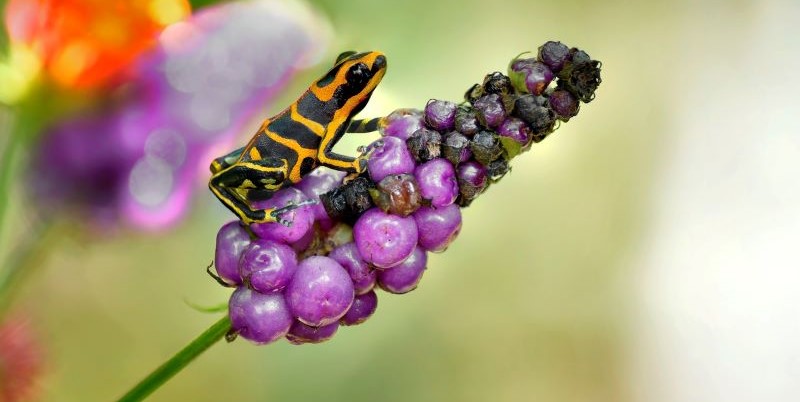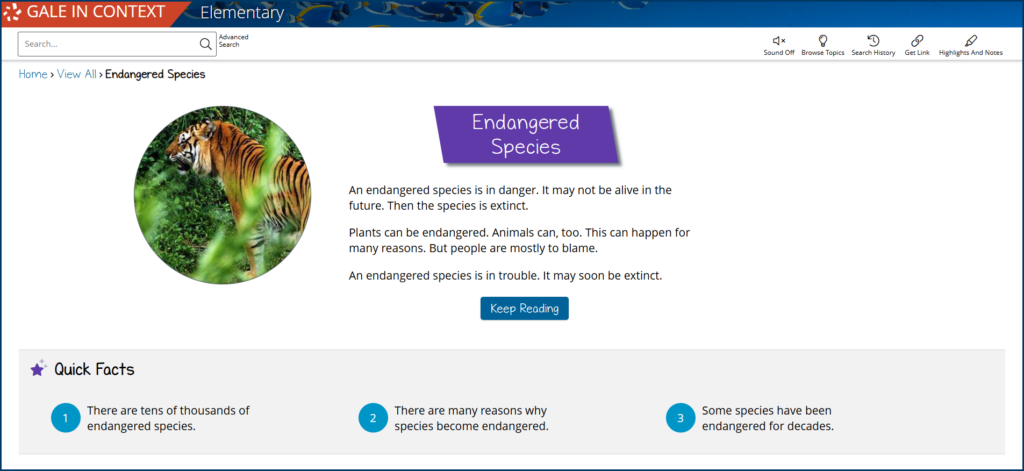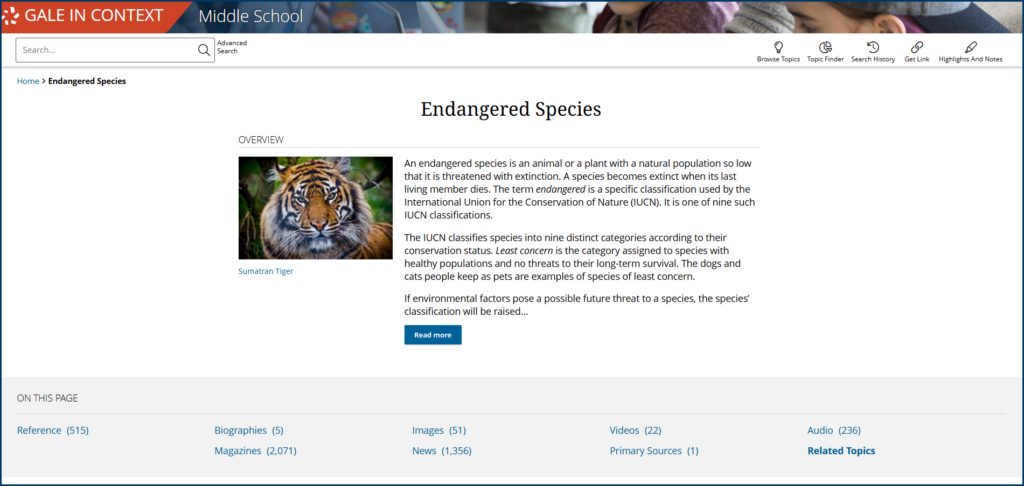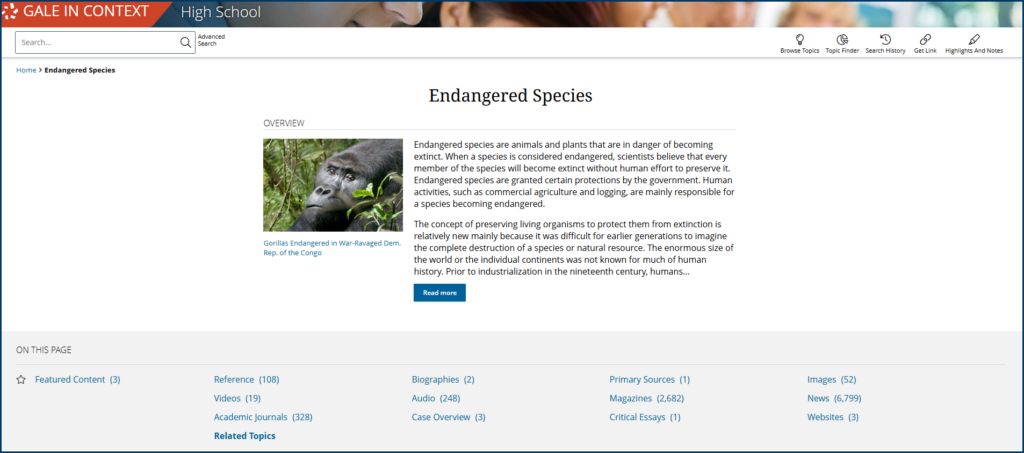In 2023, the International Union for Conservation of Nature (IUCN) released alarming news: more than 44,000 species worldwide face extinction, an approximate 5% increase from the previous year’s measurements. The IUCN, which tracks global biodiversity, blames climate change and human-created hazards, like pollution and urbanization.
These endangered species—including plants, fungi, and insects—balance ecosystems, reflect environmental health, and contribute to a healthier, more resilient planet. They have the potential to advance science and medicine, while also providing beauty, joy, and cultural significance to our communities.
On the third Friday of each May, the Endangered Species Coalition hosts a global day of education and action to protect our planet’s most vulnerable species. This spring, Endangered Species Day is May 16, and educators of all grades can help raise awareness for the cause.
Using your school’s Gale In Context subscription, you can effortlessly develop age-appropriate K-12 lesson plans and activities. With your help, students will develop curiosity and empathy for the natural world. Losing just one endangered species, no matter how small, can initiate far-reaching consequences for its delicate ecosystem.
Help Elementary Students Understand the Importance of Wildlife
Endangered species can be a challenging topic for younger students. It’s devastating to consider that, due to human activity, the next generation could live without beloved creatures, like certain breeds of tigers or penguins. Gale In Context: Elementary provides a tailored experience to learn about endangered species. With strong visual elements and simplified sentence structure, information is accessible and inviting for elementary students.
Explore Frogs’ Resilience, Endangerment
Frogs are remarkable; because of their unique physiology, they can live in aquatic or terrestrial environments. Their skin is permeable, which allows them to absorb oxygen while underwater. However, this captivating evolutionary trait makes them susceptible to environmental contaminants.
Worldwide, frogs are among the most endangered species. Amphibians, including frogs, are particularly sensitive to environmental changes, whether through habitat destruction, pollution, invasive species, or climate change. As a result, hundreds of frog species have gone extinct in the last 50 years.
Because of their sensitivity, scientists consider amphibians indicator species. Indicator species, like frogs, are valuable barometers of an ecosystem’s overall health. If amphibians struggle to survive in a particular setting, the environment likely contains serious risk factors for other life forms (including humans). Scientists rely on indicator species populations as a barometer for a region’s overall environmental viability.
Activity Idea: Frogs are resilient; they’ve existed for more than 200 million years. Using Gale In Context: Elementary, discover some of the clever frog’s survival strategies, such as hibernation, toxins, and camouflage—they are incredibly adept at hiding themselves. See if students can find the 12 sneaky frogs in this image. Have students discuss why some frogs are at risk of extinction despite their many incredible adaptations.
Learn from past Extinction Events with Middle Schoolers
We designed Gale In Context: Middle School to help middle schoolers foster their critical thinking skills. The endangered species content is more in-depth and academically rigorous than our elementary database. Still, it retains the platform’s signature user-friendly search features, reading companions (like fast facts and key vocabulary), and colorful graphics.
Delve into Earth’s Extinct Species
Scientists don’t know exactly how many different species exist on Earth, and estimating how many have lived throughout history is even more challenging. We’ve all heard about dinosaurs, saber-toothed tigers, and woolly mammoths—but what other incredible creatures once lived on our planet? And what can we learn from them to prevent ongoing extinction?
In some ways, extinction is a natural process. Species are constantly evolving and competing for resources; some will not adapt as quickly to survive. In fact, most of the planet’s species were long gone well before humans arrived. Using fossils and geological data, scientists can calculate the background extinction rate, or the rate at which species naturally go extinct. This research suggests that the current extinction rate is hundreds to thousands of times higher than previous levels .
Roughly 10,000 years ago, extinction rates increased beyond normal values when humans began farming and forming settlements. Then, in the 19th century, industrialization catalyzed a dramatic increase in extinction rates. Human expansion is accelerating species’ extinction, permanently threatening the planet’s biodiversity.
Activity Idea: Extinct species are compelling, unique, and sometimes totally weird. A two-ton, slow-moving giant sloth once roamed Arizona. Eight-foot millipedes called Arthropleura used to skitter around northern England. Massive sharks called Megalodons would hunt the oceans. Encourage students to select and research an extinct species. Why didn’t it survive, and what can we learn from its story?
Turn Awareness into Action with High Schoolers
With graduation on the horizon, high schoolers are looking to the future and eager to make a positive impact in the world. Gale In Context: High School resources can help you invigorate their curiosity and empower them with knowledge. With well-structured information and guided critical thinking questions, this database helps users grapple with complicated societal issues—including threats to endangered species and the concrete ways that humans can help.
Action on the National, Local Level
While humans are responsible for the current endangered species crisis, we also have the ability to make positive changes. Using Gale In Context: High School, students can discover countless ways in which conservation science efforts are tracking and even saving endangered species.
Action to help mitigate extinction is possible. On a larger scale, legislation can mandate important environmental safeguards. In 1973, Congress passed the Endangered Species Act, offering expanded protections to species identified as endangered. The law limited human activity in more vulnerable habitats and bolstered endangered species repopulation efforts.
On a more local level, the Student Conservation Association (SCA) is a national nonprofit that connects motivated students with hands-on activities to help protect public parks. SCA members help clean green spaces, remove invasive species, and build park benches.
Activity Idea: Find an article that discusses creative solutions to protect endangered species. Could a mammoth-hybrid help prevent elephant poaching and preserve permafrost in the tundra? Can drones help monitor vulnerable koala populations? Ask students to define the problem addressed in the article and why the proposals may or may not be effective. As a class, imagine you have funding to invest in one of these solutions; vote on which initiative you believe is the best investment.
Protecting endangered species sometimes seems at odds with other human interests, which poses the question: how much should we protect other species over our own interests? (And to what degree are our interests interconnected?) Gale In Context can help your classroom think critically about this debate as students navigate the balance between human interests and animal welfare.
Every species has a right to survive on the planet, and every organism has a vital role in its ecosystem. Losing just one species could pose long-term consequences, and humans are just as vulnerable to the potential cascading effects. It won’t be easy, but our welfare depends on our planet’s biodiversity.
If your district does not currently subscribe to Gale In Context, contact your educational consultant for more information and a trial of our groundbreaking classroom products.




